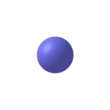| |||
| Names | |||
|---|---|---|---|
Other names
| |||
| Identifiers | |||
| |||
3D model (JSmol)
|
| ||
| ChemSpider | |||
| ECHA InfoCard | 100.008.306 | ||
| EC Number |
| ||
PubChem CID
|
|||
CompTox Dashboard (EPA)
|
|||
| |||
| |||
| Properties | |||
| LiSCN | |||
| Molar mass | 65.02 g/mol | ||
| Appearance | White hygroscopic solid | ||
| Density | 1.44 g/cm3[1] | ||
| Melting point | 274 °C (525 °F; 547 K)[2] | ||
| Boiling point | 550 °C (1,022 °F; 823 K) (decomposition) | ||
| 125 g/100 ml | |||
| Solubility | Soluble in alcohol[1] | ||
| Structure[2][3] | |||
| Orthorhombic (anhydrous, α-monohydrate, dihydrate) Monoclinic (β-monohydrate) | |||
| C2/m (α-monohydrate) Pnam (β-monohydrate) Pnma (anhydrous, dihydrate) | |||
a = 1215.1 pm, b = 373.6 pm, c = 529.9 pm (anhydrous)
| |||
| 4 (α, β-monohydrate) 6 (anhydrous, dihydrate) | |||
| Tetrahederal (α and β-monohydrate) | |||
| Thermochemistry | |||
Std molar
entropy (S⦵298) |
9 e.u.[1] | ||
Std enthalpy of
formation (ΔfH⦵298) |
5.0 kcal/mol[1] | ||
| Hazards | |||
| GHS labelling: | |||

| |||
| Warning | |||
| H302+H312+H332, H412 | |||
| NFPA 704 (fire diamond) | |||
| Related compounds | |||
Other cations
|
Sodium thiocyanate, Potassium thiocyanate | ||
Except where otherwise noted, data are given for materials in their standard state (at 25 °C [77 °F], 100 kPa).
| |||
Lithium thiocyanate is a chemical compound with the formula LiSCN. It is an extremely hygroscopic white solid that forms the monohydrate and the dihydrate. It is the least stable of the alkali metal thiocyanates due to the large electrostatic deforming field of the lithium cation.[1]
- ^ a b c d e D. A. Lee (1964). "Anhydrous Lithium Thiocyanate". Inorganic Chemistry. 3 (2). ACS Publications: 289–290. doi:10.1021/ic50012a039.
- ^ a b Markus Joos; Maurice Conrad; Sebastian Bette; Rotraut Merkle; Robert E. Dinnebier; Thomas Schleid; Joachim Maier (2022). "On the crystal structures of lithium thiocyanate monohydrate LiSCN 1 H2O and the phase diagram LiSCN – H2O". Journal of Physics and Chemistry of Solids. 160. doi:10.1016/j.jpcs.2021.110299.
- ^ Cite error: The named reference
diwas invoked but never defined (see the help page).


